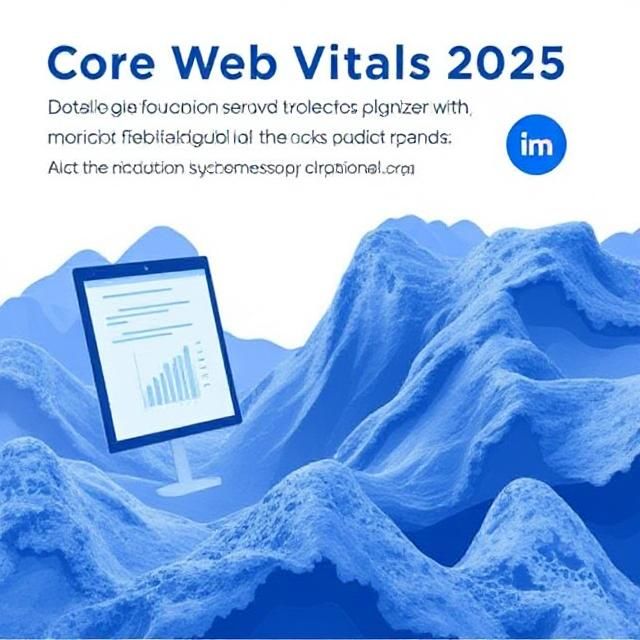5 minutes
Last Updated on Jul 3, 2025

In 2025, Google's Core Web Vitals updates showed clearly how important user experience is for SEO success. Keeping up to date with Core Web Vitals 2025 can help you hang on to your rankings and keep visitors engaged even while new metrics replace old ones.
This blog post details what’s new and offers tips on how to adapt your website for Google’s updated standards.
Core Web Vitals is a set of metrics introduced by Google to judge how your site really functions for users in terms of quickness, responsiveness, and visual stability. They are a part of Google’s big page experience update and have a huge impact on search rankings. Previously, the three main metrics were Largest Contentful Paint (LCP), First Input Delay (FID) and Cumulative Layout Shift (CLS).
But with a shift in the text this 2025 there’s a significant shift you need to know about.
This year, Google officially replaced First Input Delay (FID) with Interaction to Next Paint (INP). However, unlike FID, which measures only the time it took before the first interaction, INP measures every minute detail of how your site reacts with real users.
When users touch buttons, click on links, or enter text, they record only small bits of time after large chunks. This behavior will lead to a high INP value.
For example, if your website is initially fast but gets slow as visitors interact with menus or forms, INP will catch these delays. This metric means you have to act fast to keep users' visits smooth from beginning to end.
Google’s updated Core Web Vitals focus on these three metrics:
Largest Contentful Paint (LCP): Measures loading performance. Aim for when the page starts loading for LCP to occur within 2.5 seconds.
Interaction to Next Paint (INP): Measures responsiveness in all interactions. To ensure a smooth experience, your target should be an INP of 200 milliseconds or less.
Cumulative Layout Shift (CLS): Measures unfamiliar visual displacements when tracking the movement in real time. A good CLS score is less than 0.1.
Taken together, these metrics give a very comprehensive view of your site’s performance from the user’s perspective.
Core Web Vitals are more than just technical scores. They directly affect your business outcomes. In general, sites that meet these standards load faster, seem more responsive, and provide a stable experience, all of which encourage visitors to stay longer and convert more often. Google already uses these metrics as ranking factors. Failure to optimize them is likely to mean losing valuable search traffic compared with competitors whose websites perform better in these respects.
To fix your LCP, start with modern image formats such as WebP or AVIF and reduce the files. Faster server response times can also help reduce LCP. For INP, concentrate on reducing the duration of long tasks that block page responsiveness by using as much JavaScript language as possible to construct web page performance so that people patiently wait. Break up large scripts into smaller parts and defer unnecessary JavaScript This will allow users to interact with your site quickly, even if other elements are still loading in the background.
In terms of CLS: Always provide images and videos with an explicit width and height; avoid inserting new content into existing elements. As the page loads, this keeps layout stable and minimizes unsightly jumps that the user must endure.
You do not have to guess whether or not your site is up to snuff with Google's standards. Use tools like Google Page Speed Insights to evaluate LCP, INP, and CLS for each page, with suggestions on how to improve. Inspecting programs such as Lighthouse will help you find the specific slow-loading assets buried in your web. At the same time, the Chrome User Experience Report (CrUX) can provide you with real data on how people experience your website.
Before you launch or upgrade your site, review this essential checklist:
Optimize server response times.
Use fast image and font loading so as to keep time from stopping.
Reduce the number of JavaScript entries that stand in line.
Make sure that page element consistency is also preserved.
Guarantee that all of your elements remain visually steady.
Core Web Vitals 2025 brings more challenges and rewards than before working with the new numbers. Optimizing your site so it does all the things asked of it by these updated metrics is not simply a matter of pleasing an algorithm devised to reflect how people use Google's engine; it's also about making your visitors' experience better. Focus on getting better load times, making sure users can handle whatever happens in your web application, and providing a stable and predictable page layout.
By paying attention to these aspects, you will not just remain at the forefront in contrast to worldwide search rankings but also build trust with your users, increase participation, and lead to more conversions.